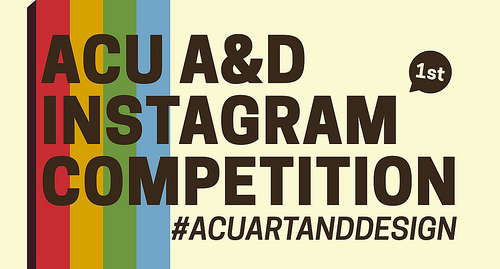Six students have won first place in various sessions of the semester-long ACU A&D Instagram Competition facilitated by the Department of Art and Design.
The competition serves as a way to connect current art students with alumni. Every two weeks, a department alumnus judges the miniature competitions.
Six winners have been named so far: Anne-Marie Coffee, senior graphic design/advertising major from San Antonio; Chancey Sanders, freshman art major from Lufkin; Stephanie Fink, senior two-dimensional art major from Fayetteville, Georgia; Matt Varner, senior graphic design/advertising major from Abilene; Ashlyn Morrison, junior interior design major from Palm Springs, California; and Hannah Bruce, senior art major from Abilene.
“I think that an in-house competition encourages students to be competitive and creative with their designs,” Morrison said. “It also helps us gauge where we stand amongst our peers. The competition is a great way for us to showcase our work not only to other students, but to the public.”
The competition was created by Mike Wiggins, chair of the art and design department, and implemented with the help of two student workers, Coffee and Breanne Avedikian, junior art major from Clovis, California.
“The cool thing is that we were just trying to get more engagement in our social media and trying to think of ways to do that,” Coffee said. “We also wanted alumni to be engaging on our social media and show them kind of what is going on in the art department and show them that it’s still awesome and thriving.”
Different alumni reach out to the department and vice versa to create a balanced group of judges as well as connect their different focuses in art with students interested in them.
“I think it’s getting more and more successful, and there are alumni who are inquiring how they can be part of the judging process, which is awesome,” Coffee said. “And the students being able to click on the hashtag and go through the artwork being submitted.”
Judges have included interior designers, graphic designers and a contemporary artist and painter. Every two weeks, the department announces the new judge, and students continue to use the hashtag to enter the competition.
“It can be a bit confusing about when one competition ends and another begins, but it doesn’t practically affect it much,” Fink said. “The low-key submission method is really nice to have during the rush of the semester. We have the big Spring Student Show competition opening this Friday, and that’s great, but it’s nice having the low-stress fun of entering this competition during the rest of the year.”
The decision to make this competition was created to continue students’ relationships with alumni. Wiggins said it seems to have strengthened those relationships, not created them out of nowhere.
“It’s important for alumni to see our student work, but a big goal is just for us to be in contact,” he said. “We could run fewer competitions and probably have more participation, maybe. But we would have that much fewer connections with alumni. If one of our goals is to really connect, I’d rather connect with more alumni more often than fewer alumni less often.”
The upside of the structure of the competition was that students could put the hashtag on a post at any time and be entered because there was always only one competition occurring at a time.
“The competition convinced me to finally get an Instagram account, which is a fabulous resource for fine artists and craftsmen both to connect with others, promote their own work and to find inspiration and resources,” Fink said.

